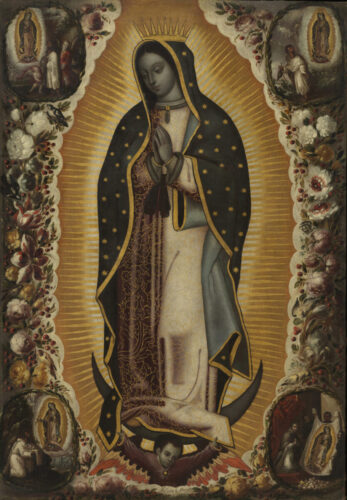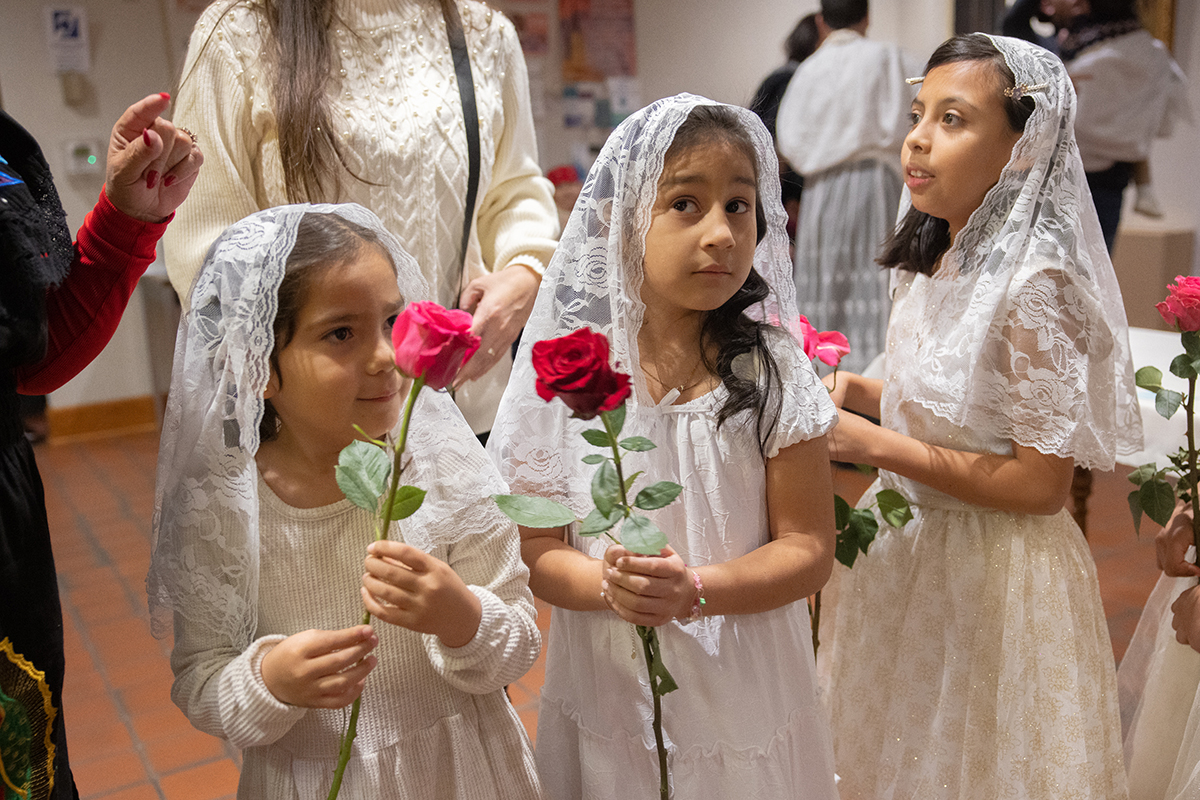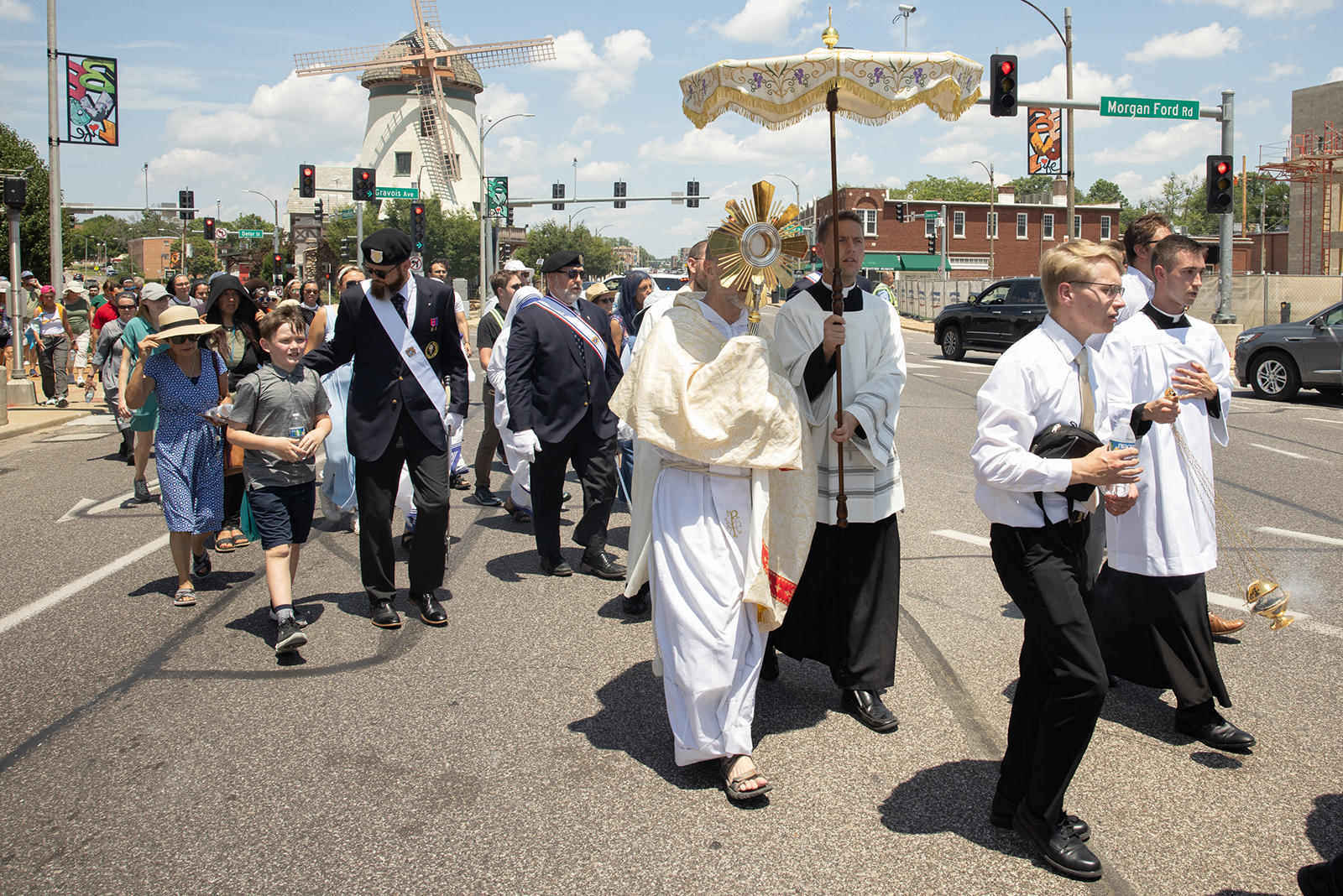New St. Louis Art Museum exhibit explores role of Christian art in Spanish America
“Art and Imagination in Spanish America” showcases range of works from 1500-1800

“Virgin of Guadalupe” oil on canvas on wood, inlaid with mother-of-pearl, by Miguel Gonzalez.
When the Blessed Mother appeared to St. Juan Diego in Mexico in December 1531, she instructed him to gather Castilian roses at the top of Tepeyac Hill. When he presented the roses to the archbishop as proof of Mary’s appearance, an image of Our Lady miraculously appeared on his tilma.
In the centuries following, countless artists have painted their own versions of the miraculous image, now known as Our Lady of Guadalupe, beautifully depicting the monumental event for Catholicism in the region. Two such oil paintings by Mexican artists welcome visitors to a new exhibit at the St. Louis Art Museum: “Art and Imagination in Spanish America, 1500-1800.”
The exhibit features more than 100 works from the Los Angeles County Museum of Art’s collection of Spanish colonial art. The majority of them were created in Mexico in the 1700s, but the collection also features art from Bolivia, Brazil, Colombia, Ecuador, Guatemala, Paraguay, Peru and Venezuela.
The collection is divided into five sections, two of which focus on religious art and its role in both personal devotion and the expansion of the Catholic faith. After the Spanish arrived in the Americas in the late 15th century, “devotional images became essential to evangelize the Indigenous population and instruct in matters of the Catholic faith,” an exhibit panel explains.

“Pietà,” oil on canvas, by Melchor Pérez Holguín.
While the first Christian art in the region was brought over from Europe, local artists soon began to create their own devotional work, drawing on a range of traditions.
“We tend to still live with this idea that everything changed with the Spanish, and many things did change. But there were a lot of long-established artistic traditions that were there when the Spanish arrived,” said Judith Mann, one of four St. Louis Art Museum organizing curators for the exhibit.
A silver gilt chalice and altar cross, dating to the late 1500s in Mexico and Guatemala, showcase the master silverwork already present in the region. The chalice also incorporated rock crystal, wood carving and feathers — understood by some Indigenous groups to be sacred objects — in a new Christian context, Mann said.
A few of the works are tied to miracles, tradition says. “Christ of Ixmiquilpan” by José de Páez depicts a large crucifix that was created from corn stalk paste for a church. The story goes that the statue had become deteriorated and moldy, and the archbishop ordered it removed from the church. But a storm lifted the roof off the church, blew the figure of Christ off the cross, and returned it in newly perfect condition. The crucifix was transferred to the Carmelite convent of St. Teresa in Mexico City, where it gained a reputation as a miracle worker.

Chalice in silver gilt, rock crystal, wood, and feathers by unidentified artists.
The oil painting of that crucifix is a “statue painting” — exactly what it sounds like — that became a traditional art form in Spanish America. Another statue painting, “Virgin of Bethlehem,” shows a figure of the Blessed Mother and baby Jesus that is still displayed in a parish church in Cuzco, Peru, and featured in the city’s annual Corpus Christi procession.
The Virgin of Bethlehem’s richly decorated garments showcase “brocateado,” a Southern American technique of applying gold leaf ornamentation to the surface of the canvas. Brocateado is also found on Bolivian artist Melchor Pérez Holguin’s “Pieta,” where the gold leaf decoration contrasts sharply with Jesus’ beaten and bloody body in Mary’s arms.
“The blood is all there, the suffering is all there. But by putting it against the background of this beautiful textural work, it kind of allows you to stand it,” Mann said. “That makes it a beautiful image that invites you in, and I think mitigates some of the force of (the blood), although it is there and it is important.”
The Blessed Mother is depicted in several more works throughout the exhibit, including a depiction of the presentation of the child Mary in the temple, her marriage to St. Joseph and the Visitation to St. Elizabeth. Mary’s popularity in the art of this time period speaks to the way the early Spanish American converts gravitated toward the Blessed Mother, a devotion that remains strong throughout Catholics in Central and Southern America, Mann said.
This is the first exhibit at the St. Louis Art Museum to be presented fully in both English and Spanish, with bilingual interpretive panels and gallery descriptions. Mann hopes that visitors will come away with a new appreciation for the art and culture of Spanish American people throughout the period of colonization.
“I do hope they understand that this is such a rich area and a rich tradition, whether you’re looking at religious images or furniture or other things, rather than seeing it as kind of ‘less than,’” Mann said. “I think there is still that kind of overriding understanding that this is not inherently very interesting material, and it’s actually quite beautiful and engaging.”
Art and Imagination in Spanish America, 1500-1800
Where: St. Louis Art Museum, 1 Fine Arts Drive in St. Louis
When: Now open through Sept. 1, 2024
Cost: Adults $12, seniors and students $10, children (6-12) $6, children 5 and under free. Members free.
Admission to the exhibit is free every Friday. For more information, visit slam.org.
“Art and Imagination in Spanish America” showcases range of works from 1500-1800
Subscribe to Read All St. Louis Review Stories
All readers receive 5 stories to read free per month. After that, readers will need to be logged in.
If you are currently receive the St. Louis Review at your home or office, please send your name and address (and subscriber id if you know it) to subscriptions@stlouisreview.com to get your login information.
If you are not currently a subscriber to the St. Louis Review, please contact subscriptions@stlouisreview.com for information on how to subscribe.





